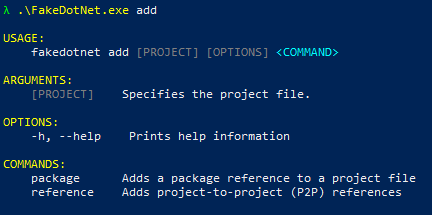I've been writing a lot of CLI apps, both at work and in my free time, and there's never really been a command line parsing framework that has fitted my needs. While being either too complex or too simple, it's always nagged me that I need to write so much code myself. What I wanted was a way to be declarative about my commands, options and arguments while still allowing composition of them.
So a year back or something like that I decided to build a small framework upon
Microsoft.Extensions.CommandLineUtils that would allow me to write my applications like I wanted to,
and it worked great (although with a lot of duct tape).
That was until I ran into bugs and other annoyances in the underlying library and discovered that they didn't accept any pull request since the library was stable for their needs and not under active development. So I decided to rip out Microsoft's library and replace it with something else, and Spectre.Cli was born.
How does it work?
The underlying philosophy behing Spectre.Cli is to rely on the .NET type system to declare the commands, but tie everything together via composition.
Imagine the following command structure:
- dotnet (executable)
- add
[PROJECT]- package
<PACKAGE_NAME> - reference
<PROJECT_REFERENCE>
- package
- add
For this I would like to implement the commands (the different levels in the tree that executes something) separately from the settings (the options, flags and arguments), which I want to be able to inherit from each other.
public class AddSettings : CommandSettings
{
[CommandArgument(0, "[PROJECT]")]
public string Project { get; set; }
}
public class AddPackageSettings : AddSettings
{
[CommandArgument(0, "" )]
public string PackageName { get; set; }
[CommandOption("-v|--version " )]
public string Version { get; set; }
}
public class AddReferenceSettings : AddSettings
{
[CommandArgument(0, "" )]
public string ProjectReference { get; set; }
}
public class AddPackageCommand : Command<AddPackageSettings>
{
public override int Execute(AddPackageSettings settings, ILookup<string, string> remaining)
{
// Omitted
}
}
public class AddReferenceCommand : Command<AddReferenceSettings>
{
public override int Execute(AddReferenceSettings settings, ILookup<string, string> remaining)
{
// Omitted
}
}
Now when we have our commands and settings implemented, we can compose a command tree that tells the parser how to interpret user input.
using Spectre.Cli;
namespace MyApp
{
public static class Program
{
public static int Main(string[] args)
{
var app = new CommandApp();
app.Configure(config =>
{
config.AddBranch<AddSettings>("add", add =>
{
add.AddCommand<AddPackageCommand>("package");
add.AddCommand<AddReferenceCommand>("reference");
});
});
return app.Run(args);
}
}
}
Now you might wonder, why do things like this? Well, for starters the different parts of the application are separated, while still having the option to share things like options, flags and arguments between them.
This make the resulting code very clean and easy to navigate, not to mention to unit test.
And most importantly at all, the type system guides me to do the right thing. I can't configure
commands in non-compatible ways, and if I want to add a new top-level add-package command
(or move the command completely), it's just a single line to change. This makes it easy to
experiment and makes the CLI experience a first class citizen of your application.
Errors
I've also put some time in making the help screens and errors more intuitive than most other command line parsing frameworks.


What else?
This article was meant as an introduction to Spectre.Cli, but the framework itself contains a lot of other things as well such as dependency injection, validation and async/await support. More about that in a later blog post!
If you want to see Spectre.Cli in action I recommend you to take a look at the sample applications in the source code repository.